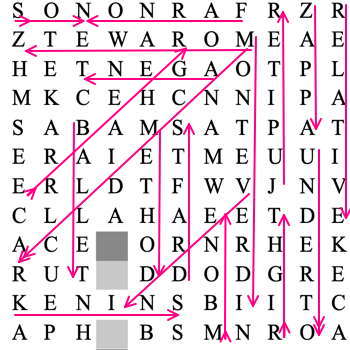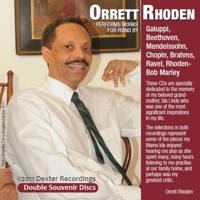 WORD SEARCH: Can you solve Allan Rae's classical music word search puzzles? We're currently publishing one per month.
WORD SEARCH: Can you solve Allan Rae's classical music word search puzzles? We're currently publishing one per month.

Rather Enigmatic
GEOFF PEARCE, after listening to 'Missa Cambrensis', wants to hear more by Welsh composer Grace Williams
'... a very compelling work on so many levels ...'
While I have heard of Welsh composer Grace Williams (1906-1977), I had not heard any of her music, at least that I can remember, so I was keen to make my acquaintance with this disc which contains her magnus opus - her last major work. Missa Cambrensis is very substantial, lasting over an hour, with text in both Latin and Welsh, soloists, mixed chorus, boys choir, a narrator and a large orchestra. The composer is quite individualist and it would be difficult to align her with any particular twentieth century school. If there is one work that I am reminded of when listening to this Mass, it would have to be Britten's War Requiem, which has the same overt brooding quality.
Missa Cambrensis was composed over two years, completed in 1970 and received its first performance the following year.
The opening Kyrie is brooding and sombre and somewhat restrained, but one can sense that there is great power. It is brief, sung entirely in Latin, starts with the orchestra, then mixed choir, and then the soloists enter, really with ensemble work, rather than with extended solos. I am reminded of a rather bleak and grey coastline.
Listen — Grace Williams: Kyrie (Missa Cambrensis)
(SRCD.442 track 1, 0:03-0:57) ℗ 2025 Lyrita Recorded Edition :
The Gloria, in six sections, opens exultantly with a trumpet fanfare and choir soon after with the text 'Glória in excélsis Deo'.
This is followed by the longest section of the Gloria: 'Laudamus Te', which is calmer and warmer and incorporates the four soloists and orchestra and the occasional passage by the choir. The latter half of the movement also has brief interweaving solos by cor anglais, violin and horn, amongst others.
'Domine Deus' is rather lilting, for choir and orchestra, with a small solo part for the contralto at the end.
Listen — Grace Williams: Domine Deus (Missa Cambrensis)
(SRCD.442 track 4, 0:00-0:37) ℗ 2025 Lyrita Recorded Edition :
In contrast, 'Qui tollis peccata mundi' is scored for the four soloists and lightly scored orchestral forces.
Listen — Grace Williams: Qui tollis peccata mundi (Missa Cambrensis)
(SRCD.442 track 5, 1:18-1:58) ℗ 2025 Lyrita Recorded Edition :
'Quonium to solus sanctus' is very brief - just a minute - and dramatic, featuring the soprano and tenor soloists, with a cor anglais solo at the end.
The final section of the Gloria is 'Cum Sancto Spiritu', featuring the chorus and orchestra in a rather gigue-like section.
The Credo is the largest section of this Mass setting and opens with 'Credo in unum Deum' - rather static and sombre with long held notes on various instruments and by the choir. The soloists enter, starting with the contralto. This recaptures much of the original mystical opening Kyrie.
This is followed by the lovely 'Carol Nadolig', the first of the Welsh texts and not part of the mass proper. This lightly scored section for orchestra and children's choir is a delightful carol composed by Grace Williams in 1955, celebrating Christ's birth.
Listen — Grace Williams: Carol Nadolig (Missa Cambrensis)
(SRCD.442 track 9, 0:00-0:36) ℗ 2025 Lyrita Recorded Edition :
This is followed by the conclusion to the Credo proper, for orchestra, mixed choir and soloists. I feel it is a heartfelt affirmation of faith.
'Beatitudes' is for narrator, accompanied by strings and oboe. It is touching and intimate, yet ends powerfully.
Listen — Grace Williams: Beatitudes (Missa Cambrensis)
(SRCD.442 track 11, 2:03-2:41) ℗ 2025 Lyrita Recorded Edition :
The crux of the Credo is the 'Crucifixus', which is also the true heart of this work and by far the largest section. At first it is sad and brooding, with a feeling of inevitability. Like much of the work, it mixes soloists with choir. The orchestral forces are weighty at times, and at others quite nebulous. About half way through this section, the full forces are unleashed briefly, then the music subsides before building up again. The feeling here, rather than being of sorrow and resignation, is more of exultation and hope.
Listen — Grace Williams: Crucifixus (Missa Cambrensis)
(SRCD.442 track 12, 5:10-5:59) ℗ 2025 Lyrita Recorded Edition :
The Sanctus starts triumphantly in exclamatory fashion and is quite grand, with bass brass and bells. (It sort of reminds me a little of the Coronation scene in Boris Godunov.) To me this is a little foreboding, but then the mood calms down, becoming tender, before the celebratory mood breaks through again. Calmness and tenderness end this rather complex movement.
Listen — Grace Williams: Sanctus (Missa Cambrensis)
(SRCD.442 track 13, 5:23-6:03) ℗ 2025 Lyrita Recorded Edition :
Still part of the Sanctus is the 'Benedictus', which starts with a long orchestral opening, largely for strings, with a beautifully evocative and soaring oboe solo. This reminds one of a slow and stately march. When the chorus enters, this is not abrupt and does not disturb the mood. The bass soloist enters, and lower brass and strings darken the colour, and this becomes a little more dramatic when the other soloists enter. It reminds me of a procession climbing a stairway. Quieter strings, oboe and the vocal soloists end this rather gorgeous movement.
The opening of the Agnus Dei is powerful and anguished - not normally what one would expect from a lamb of God. Brooding and rather forlorn, it ends calmly and quietly.
'Dona Nobis Pacem', the final section, brooding at first, is marked 'Senza misura' and delivers an effect rather like plainsong. As musical material from some of the previous sections is revisited, and the grand climax occurs near the end of the movement, this makes a very satisfying end to this rather enigmatic work.
Listen — Grace Williams: Dona Nobis Pacem (Missa Cambrensis)
(SRCD.442 track 16, 5:41-6:37) ℗ 2025 Lyrita Recorded Edition :
It is amazing to think that the first performance of this powerful work was as late as 2016 and that this current album is the first commercial recording. It has left me with a desire to hear much more of Grace Williams' very individual musical voice.
The attached notes are comprehensive and intuitive. I was a little disappointed with the recording itself (as I felt it sounded a bit compressed and this muddied things more than I would have liked), but in the download there was a text file which said 'HD Audio Available Upon Request' and to do the music justice, it would need that. Whilst I found the orchestra and choruses very good, I have to say, in all honesty, that I found the rather wide vibrato which all soloists employed much of the time to be rather off-putting. However, that is a personal observation, and this may not irritate other listeners as it did me. This is a very compelling work on so many levels, and it is certainly worth familiarising yourself with this work and composer.
Copyright © 19 March 2025
Geoff Pearce,
Sydney, Australia




